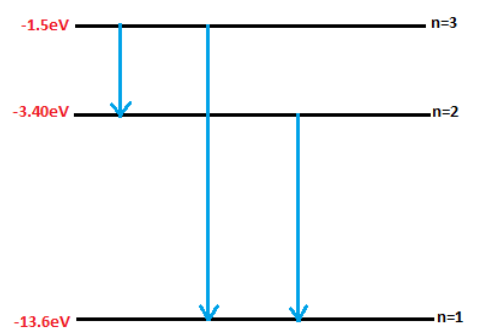Question
Question: The ionization energy of the hydrogen atom is 13.6 eV. A hydrogen atom in the ground state is excite...
The ionization energy of the hydrogen atom is 13.6 eV. A hydrogen atom in the ground state is excited by the electromagnetic radiation of energy 12.1 eV. How many spectral lines will be emitted by the hydrogen atom?
(A). One
(B). Two
(C). Three
(D). Four
Solution
Hint: Here we first calculate the difference between the ionization energy and the radiation energy. Then using the formula E=−n2E0 we can calculate the energy state in which the hydrogen atom is present after excitation which is coming as 3rd energy state. Then write all the possible transitions like 3rd to 2nd, 2nd to 1st, and 3rd to 1st which will give us 3 spectral lines.
Formula used: E=−n2E0
Complete step-by-step solution -
Ionization energy denoted Eᵢ, is the minimum amount of energy required to remove the most loosely bound electron that is the valence electron, of an isolated neutral gaseous atom or molecule.
We know that the ionization energy of the hydrogen atom at the ground state is equal to -13.6 eV.
Now, this hydrogen atom is excited by electromagnetic energy equal to 12.1 eV.
So the energy difference is
ΔE=−13.6+12.1=−1.5eV------------------ (!)
that is the same as the energy of hydrogen atom in excited state
E=−1.5eV----------------------------- (2)
Now we know that the energy level of hydrogen is given by the formula
E=−n2E0------------------------------- (3)
Here E0=13.6eV and n=0,1,2,3 …and so on is the energy level where the atom is present.
Now equation (3) in equation (2) we will get
⇒−1.5=−n213.6
⇒n2=1.513.6=9.067
⇒n=9.067≈3
Therefore, Hydrogen is excited by radiation to the third energy state. Now the possible spectral lines that can be emitted are from 3rd to 2nd, 2nd to 1st, and 3rd to 1st. Therefore 3 spectral lines will be emitted by the hydrogen atom as shown in figure 1. Hence, option C is correct.

figure 1
Note: For these types of questions, we first find the energy difference ionization energy and radiation energy. Then recall the formula for the energy level of the atom which is E=−n2E0, here E0 is the ionization energy of the atom chosen. After that, we can simply solve for n to get the energy state where the atom is present, and then by writing all the possible transitions from that state to lower state we will know the number of spectral lines.
